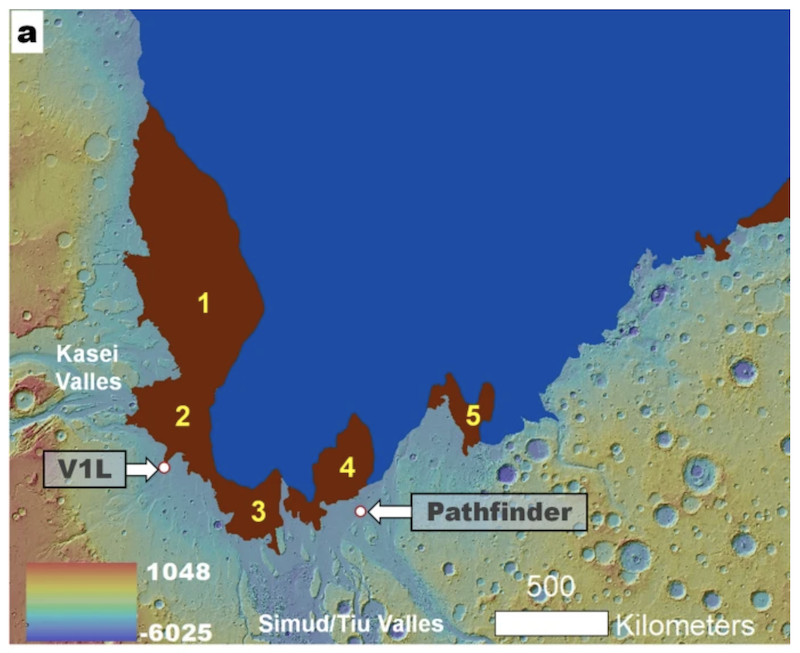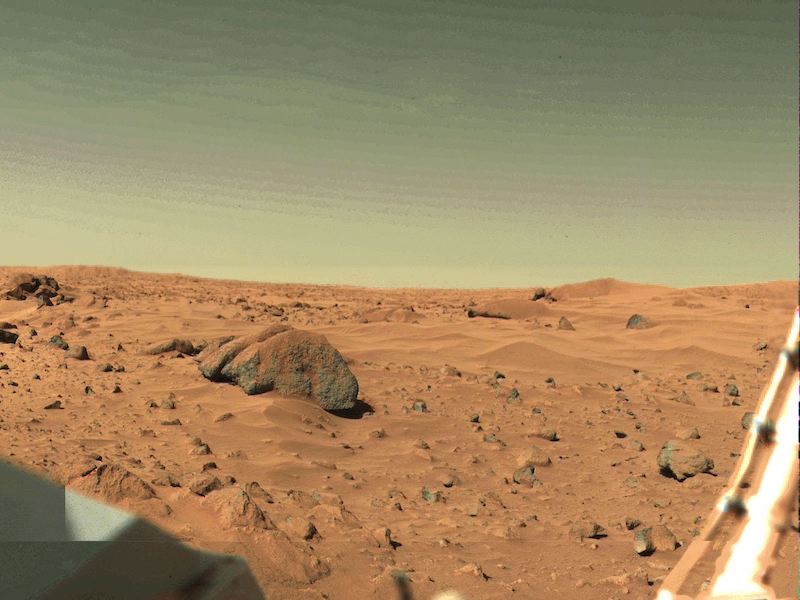The primary spacecraft to land on Mars – Viking 1 – set down on July 20, 1976. It landed on the decrease reaches of an historic river channel, in a easy round plain referred to as Chryse Planitia, in Mars’ northern hemisphere. This month, researchers introduced that an historic megatsunami may need deposited the boulders, rocks and different sediments seen in Viking 1’s iconic first photos from Mars’ floor. The proof suggests an asteroid struck a long-gone Martian ocean, not removed from what later grew to become Viking 1’s touchdown spot. The ensuing megatsunami seems to have washed ashore near the place Viking 1 nonetheless rests on the floor of Mars.
Lead writer Alexis Rodriguez on the Planetary Analysis Institute and his colleagues published their peer-reviewed findings in Scientific Stories (Nature) on December 1, 2022.
Debate concerning the Viking 1 touchdown website
The mission staff selected the touchdown location, in Chryse Planitia, as a result of the truth that it was pretty flat and protected. However there was one more reason, too: water. Viking 1 landed on the decrease a part of an historic river channel. Huge floods tore via this space billions of years in the past. Viking 1’s main mission (in addition to Viking 2) was to search for evidence of microbial life. And the place there had been water, there might have been – or might nonetheless be – residing organisms, too. Rodriguez said:
The lander was designed to hunt proof of extant life on the Martian floor, so to pick out an acceptable touchdown website, the engineers and scientists on the time confronted the arduous process of utilizing a few of the planet’s earliest acquired photos, accompanied by Earth-based radar probing of the planet’s floor.
Along with assembly tight engineering constraints on the spacecraft’s orbital and descent paths, the touchdown website choice wanted to meet a important requirement, the presence of intensive proof of former floor water. On Earth, life all the time requires the presence of water to exist.
No signal of riverbed at Viking 1 location
When Viking 1 landed, nonetheless, its cameras confirmed the terrain was coated by many rocks, boulders and sand drifts. There wasn’t something that appeared fluvial – carved by water – that you’d anticipate to see in an outdated dried-up riverbed. As Rodriguez famous:
Nonetheless – and really unexpectedly – the in-situ imaged landscapes revealed boulder-strewn plains missing recognizable fluvial options. These plains have been interpreted to be the highest of a boulder-rich deposit a number of meters thick.
Scientists posited varied theories, for instance, that Viking 1 landed on a thick subject of particles from affect craters or damaged up lava. There was an issue with each concepts, nonetheless. There have been very view affect craters close by and there was a scarcity of lava fragments on the touchdown website. So then how did all these boulders and rocks get there?
A megatsunami in Chryse Planitia?
It may not have been rivers or flash floods that delivered the boulders and enormous rocks, however one thing much more highly effective: a megatsunami. Rodriguez stated:
Our investigation supplies a brand new answer, {that a} megatsunami washed ashore, emplacing sediments on which, about 3.4 billion years later, the Viking 1 lander touched down.
Rodriguez had hypothesized in an earlier paper that there had really been two megatsunamis within the area, about 3.4 billion years in the past.
Megatsunami would have reached Viking 1 touchdown website
Scientists recognized Pohl Crater because the probably affect website of an asteroid that generated the primary megatsunami. On the time of the affect, the placement of Pohl Crater was underwater, within the northern ocean. The 68-mile (110-km) diameter crater is about 560 miles (900 km) northeast of the Viking 1 touchdown website. Rodriguez and his staff created simulations of the affect. They confirmed that the megatsunami would certainly have reached the placement of the place Viking 1 is now. The large megatsunami reached an estimated peak of 820 ft (250 meters)! As Rodriguez defined:
The simulation exhibits that this megatsunami reached the Viking 1 lander website. Moreover, our examination of the touchdown website utilizing larger decision picture datasets identifies that it’s on prime of a highland-facing lobate deposit, in keeping with its emplacement as a result of run-up stream propagation.
Co-author Dan Berman of the Planetary Science Institute added:
We focused an orbiting spacecraft to acquire 25-centimeter-per-pixel photos, which we obtained just some months in the past, and generated high-resolution topography from them. The outcomes have been gorgeous. They clearly present proof of run-up and dissection by highly effective flows.

The Pathfinder touchdown website
As well as, the researchers say that the megatsunami might also have reached the touchdown location of NASA’s Pathfinder lander, which touched down in Ares Vallis on July 4, 1997. That touchdown website can be alongside what would have been the traditional ocean shoreline. The megatsunami might also have created an inland sea on this area.
The Pathfinder landing site is 527 miles (850 km) southeast of the Viking 1 website.
Implications for all times
The brand new findings additionally present clues concerning the potential habitability of Mars a couple of billion years in the past. Rodriguez stated:
The ocean is believed to have been groundwater-fed from aquifers that probably shaped a lot earlier in Martian historical past – over 3.7 billion years in the past – when the planet was “Earth-like” with rivers, lakes, seas and a primordial ocean. Consequently, the ocean’s habitability might have been inherited from that Earth-like Mars; the event of transient habitability just isn’t enough; we want sustained continuity. So, the Viking 1 lander website was effectively suited to hold out the life detection experiment.
Assessing habitability and future exploration
Rodriguez continued:
Relating to our future plans, our subsequent step might be to characterize Pohl as a touchdown website to research how the ocean chemistry developed, its habitability and a attainable geologic file containing proof of present or extinct life proof. The location is engaging for in-situ exploration in lots of respects. Proper after its formation, the crater would have generated submarine hydrothermal techniques lasting tens of 1000’s of years, offering vitality and nutrient-rich environments.
As for particular targets, we discover quite a few attainable mud volcanoes over areas of the second megatsunami overlaying and surrounding Pohl. Our observations counsel that these options extruded regionally megatsunami-retained seawater and marine sediments throughout prolonged geologic occasions. Sampling these supplies would maximize the chances of straight probing the habitability of this Mars early ocean. Our future characterizations will search to establish a comparatively small website providing entry to your complete marine file. Such a terrain would benefit a rover’s go to.
If the megatsunami interpretation is right, it supplies a glimpse into a really completely different Mars than the one we see immediately. A moist ocean world with big tsunamis? Unbelievable.
Backside line: A global staff of researchers stated that when NASA’s Viking 1 lander touched down on Mars in 1976, it landed close to the sting an historic megatsunami deposit. An asteroid affect about 3.4 billion years in the past created the megatsunami, the researchers stated.
Source: Evidence of an oceanic impact and megatsunami sedimentation in Chryse Planitia, Mars





